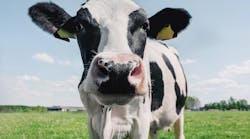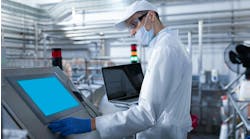Smart milking case study: Modern dairy redefines efficiency
The cows don’t mind the automated processes.
In fact, once they get used to how the milking carousels work—a slow-but-efficient eight-minute spin for 106 animals at a time around a giant, autonomously operated hub that extracts and collects their liquid output into a central pipe—the cows eagerly climb into the stalls, as they are relieved to unload their udders three times each day.
Camera-guided autonomous robots spray the udders before the milking, then rinse them down afterward. In colder months, this post-spray includes an anti-freeze component. The only step that has yet to be automated, in fact, is the act of attaching the nozzles to the udders. “We call that step the race to the moon,” explained Nick Reichelt, who as owner of Automation Werx oversees this digitalization program that relies on Rockwell Automation’s PlantPAx systems to keep milk (and profits) flowing smoothly.
The owners and staff at Millenkamp Cattle in Jerome, Idaho are thrilled with the recently adopted automation processes, which requires less human intervention while optimizing the entire process, from feeding to milking to prepping and then shipping the million+ pounds of milk produced each day just within Barn #2 at the massive farming complex.
“All of this was made possible with PlantPAx.” Automation Werx’ Nick Reichelt explained how the company helped Millenkamp Cattle dramatically streamline milking processes at the organization’s Jerome, Idaho, facility.
After their ride on the milking carousel, the cows return to newly cleaned stalls stocked with fresh supplies of feed and even air mattresses. “Cow paradise” is how it’s described at this Automation Fair case-study presentation by Reichelt, who explained the motivations, challenges and wins with this ongoing project.
“We sat down with Rockwell and decided PlantPAx was the right solution,” he said about the initiative’s launch in 2018. “It has the tools and support for properly sizing a system like this, along with the network-design capabilities. We wanted to be sure we could trust this system.”
The operators trust the system as much as the cows do the carousel. Consider these gains achieved over the past four years with smart, digital approaches to the ancient art of milk-collection:
The Millenkamp staff members were attracted to virtualized templates within PlantPAx, which speeded implementation and adoption, and rely on standardized processes that are easy to communicate to stakeholders.
Operators wanted greater insight into breaks. With a PowerFlex 755 operating the milking carousels over Ethernet/IP, operators can now quickly diagnose safety or drive issues and easily swap out hardware as needed.
Team members credit PlantPAx for eliminating network glitches and reducing downtime.
Intuitive displays on high-performance HMIs keep farmers on the milking floor and in the C-suite fully informed of production rates with real-time updates.
The PlantPAx System Estimator tool took the guesswork out of determining how many servers and hard drives were required to complete the initiative.
“For the 400 employees at this facility, we are redefining what farming looks like,” said Reichelt, who detailed an example of how new, smart cleaning-in-place procedures at Barn #2 slashed wash times and reduced costs by $12,000 a day. Case-in-point: what previously required manual testing of fluids running through pipes (you can’t have any of the acidic cleaner mixing with the dairy, lest you wind up with cheese) is now performed with conductivity sensors that autonomously detect aberrations. “All of this was made possible with PlantPAx.”
In a testament to the success of these programs, Millenkamp Cattle is scaling its efforts and building new facilities following these models to enable even greater volumes of production at additional barns. And, in keeping with their mission of extreme efficiency courtesy of smart, digital tools, Reichelt explained how the cattle farm is working on a project to convert the methane produced within their facilities into natural gas to be use by consumers to, say, prepare themselves a nice glass of warm milk.
By Chris McNamara, Smart Industry editor in chief



